“Daddy, why do you have so many owies on your feet?” “Because I skied really far.” “Why did you ski really far?” “Umm, that’s a good question… I don’t know, I guess I just kind of like doing it? Sometimes it’s nice to see just how far you can go.” “Where did you go?” “Well, you know that mountain hut near Squamish we always ski to to make grilled cheese on the stove? From there to Whistler.”
I’ve been wanting to ski the McBride as a speed traverse for quite some time – years, in fact – but the conditions/timing have never quite lined up for me. Since there’s so much steep terrain I’d figured the best way would be to do it all at night, when everything is frozen solid, during a full moon. It’s been years since there was good weather, good snowpack, a weekend, and a full moon all at the same time on the Coast. Early last week the conditions this weekend looked like they might be just right – there was a huge warming period last week, followed by a cool weather system, and a weak high-pressure ridge. I didn’t want to make the mistake Skyler and I made years ago on the Tantalus and go on the first break – we had brutally sticky snow which did not make for fast travel. I wanted to let things loosen up and re-freeze at least once. So I waited out Saturday and picked Sunday-Monday. I’d had that Monday booked off work since January, just in case. But the weather forecast degraded – it was supposed to become overcast (or partly cloudy, depending on the forecast) around midnight. It wasn’t clear if it was going to be that sort of high-altitude overcast that gives you extra time before things melt or whether it would be a whiteout. But I knew I had to be out there and see how it went – my fitness is probably the best it’s ever been and I’ve been watching the best snowpack in a long time disintegrate under mostly-rain all spring; also, with a new baby on the way, I don’t think I’ll get another chance to spend so much time away from the family next year. My schedule put me just before the turnaround point (where it’s less work to go back than forwards) at around midnight, so if a whiteout settled in I could always follow my GPS track back. Whiteout navigation at night is actually easier than during the day because you still get contrast on the snow in front of you from your headlamp. So with a GPS track for overall navigation, and headlamp to keep me from skiing off a cornice or into a crevasse, it would be “easy” to get back. At a minimum I would learn some things. I was excited all week. Since I was solo, and with somewhat uncertain weather, I carried bivy gear and a stove in addition to the usual ski-touring stuff, crevasse self-rescue kit, and a ton of food.
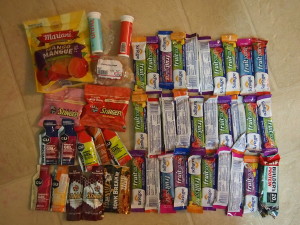
1.8 kg of mostly-sugar. Note the single quasi-non-sugar item (protein bar) in the bottom corner. I tried to eat it at the halfway point and my body refused.
Caroline picked me up from the bus stop and dropped me off at the Red Heather carpark in the middle of the afternoon in gorgeous weather without a hint of sticky snow – so probably I’d gotten the timing wrong and should have left Saturday. But it was just so great to be out and stoke levels were high. I made good time, passing by Elfin Lakes after about 1.5 hours. Too good, actually – I made a mental effort to slow myself down a bit. The McBride is pretty far, and pretty committing. I needed to be sure and leave myself some gas in the tank. After crossing the Neve and the Glacier Pikes I turned right and skied off towards the Upper Pitt River instead of down into Sentinel Bay. I’d hoped to contour around and save elevation getting into Gray Pass but was a bit too early – although things had started to cool off the snow hadn’t firmed up yet and the possibility of getting caught in a wet slide forced me to turn around and ski down to the valley bottom and skin back up. It would be the first of many delays.
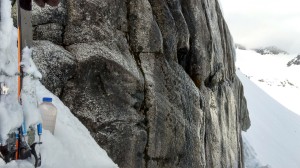
I may not have been able to contour into Gray Pass, but at least I found “free” (if you don’t mind a bit of climbing) water.
As planned, darkness fell right as I entered the McBride. I put on my headlamp as I passed by Luxor, but didn’t really need it due to the light of the full moon. A lone valley cloud rose up and enveloped me in a whiteout as I tried to contour around the Minute Hand and onto the col with Sinister Ridge. Although the Gatekeeper seems to get much of the press, Sinister Ridge is often the crux of the McBride. Even though I’d done the McBride once before, years ago and the other direction, it still caught me off guard. It was hard, much harder than I remembered. The right (SE) side of the ridge is very steep and rocky, and the left (NW) side is generally just one massive cornice. The safest route is to go over the top, but the wind features on it were really intense this year – I had to take off my skis numerous times to kick steps up and over all these blowhole walls with near-vertical sections roughly twice as tall as me. Since they were south-facing they had re-frozen and were quite firm to say the least. I had decided that an ice-axe and crampons were too heavy, so all I could do was jam my skis in on an angle for hand holds, kick steps as best I could, and just sort of muscle my way up. Certainly didn’t seem like very efficient travel, and in all the excitement I temporarily forgot to keep my calorie intake up. But the valley cloud vanished as I passed over Sinister and I had clear skies on the traverse down to Drop Pass and to start climbing around Fake Peak.
Traversing around the North side of Fake Peak was when I noticed the first real problem with my plan. Although, in mellow terrain, a full moon seems as good as daylight one notices a distinct difference in steep terrain. You see, in the day, the whole sky is bright. So even things that are in shadow are still visible. Not so by moonlight – if it’s not directly illuminated you get nothing. So on all the North facing terrain all I had was my headlamp – most of the slopes seemed to just roll off into oblivion. That and there was actually a fair amount of fresh snow, sometimes wind affected. On a couple slopes I wasn’t certain enough about stability to traverse them, so I wound up backtracking to go up-and-over. However, at around midnight, high-altitude cloud rolled in and it seemed like I might get the perfect conditions I was hoping for. I was so excited to be out there, and pressed on.
All-in-all I was behind schedule, but still not doing too bad, when the whiteout rolled in around dawn just before I passed by Sir Richard. I skied by braille down into the upper Cheakamus river, where it was snowing gently and birds were singing, picked up some water, made a short-lived navigation error, and then slogged my way back up the Naden glacier, back into the white, and back to snails-pace nagivation.

The Upper Cheakamus River. I stayed on the North side, which is a bit of a bushwack but where I wanted to end up. Just before heading off towards the Spearhead there was this perfect snow bridge. Oh well.
I’d sort-of figured that the Spearhead would be covered in skiers, or at least tracks, but not so. I’d also been hoping to cut over to and across the Ripsaw Glacier, to head down the Shatter Glacier and on to Wedge Pass ala Peter Alig and Klaus Haring (summer, 1972). But in the whiteout I just couldn’t figure it out, or at least not with the margin of safely I wanted. I poked around around a long time looking for a way over there and a few other places before finally giving up and travelling further into the Spearhead, where I spent more hours trying my best not to fall off a cornice, into a blowhole, or off a cliff due to the thick whiteout. Despite having done a fair amount of skiing on the Coast, I’m not actually super-familiar with the Spearhead – I’ve only done it twice, once on the way to the McBride years ago, and once following Lena around and too busy bagging every side-peak to actually pay attention to directions.
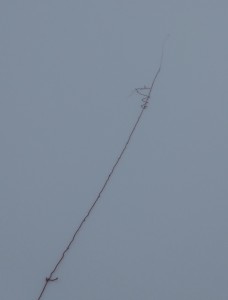
If you’ve never been in an alpine whiteout, this is what it looks like. White. All directions. A good trick (as seen here) is to tie a string to a bag filled with snow. Then you throw the bag, so you can see where the ground is. Or, importantly, whether or not there is any ground at all. Eventually I got tired of holding the string – that way I could throw it farther – but then accidentally threw it off into the void. I felt bad about littering, but better it than me – that was the point.
I finally picked up some tracks somewhere between Quiver and Tremor. I followed them as they dropped down onto and began traversing the Tremor glacier. Seemed like they were going for the col with Pattison. Then the tracks abruptly ended. I eventually figured out that they’d put skins back on, followed their tracks up a bit, then taken their skis off and started just walking down the glacier towards the flats. I could faintly hear sounds of aluminium shovels clanging around, then three sharp whistle blasts. I skied off along the boot tracks and found two skiers who’d just finished setting up their tent. Our conversation started out something like: “Does three whistle blasts mean I’m tired of being in this whiteout?” “Yeah… where’d you come from?” “Red Heather.” “Wait – I’m confused.”
They’d been trying to escape the Spearhead, but eventually decided the whiteout was too thick so they retreated to the flat part of the glacier to set up their tent and wait it out. A fairly sensible idea, really. We figured out that we sort-of knew each other through Lena and Vance/Kirsten then looked at our maps together. They knew right where they were, but didn’t feel comfortable with the whiteout. I offered to lead them out, but they didn’t think they could keep up and, besides, they still had to take down their tent and wanted a chance to eat first. We decided on the route out via Decker Creek, and the plan was that they’d eat then pack down and follow my tracks. I suspected they might actually just camp for the night, as it looked like they’d had a long day. I hope if you two did follow my tracks you found my little notes in the snow and made it out!
Conditions deteriorated as I slowly made my way out, alone in the whiteout again, with wind and precipitation picking up. My feet, which had been in pristine condition up until this point, became wet and rapidly deteriorated. I finally picked up good tracks again on the Decker glacier, and shortly afterwards dropped below the cloud ceiling and regained the ability to see where I was going. A few phone calls later and Caroline was heading up the Sea-to-Sky to pick me up, and I was skiing down the groomers back to Whistler Village. I washed my feet in Fitzsimmons Creek, and we stopped in the Squamish Shopper’s Drug Mart to pick up some essentials – some sandals and a toothbrush. After spending the night on her couch I was on the first commuter bus back to Vancouver the next morning and straight back to work (arriving even earlier than usual) carrying skis and all, even though I also had Tuesday booked off. It’s been very busy times recently, so I was glad to be back.
In the end I didn’t get quite as far as I’d hoped, but I still learned a lot about the route and myself:
- The McBride, especially solo at night, is more difficult than your average slog. I was glad to have razor-sharp edges and ski crampons. An ice axe, or at least whippet, might have been nice too.
- I can ski continuously for 29h 9m, and still do OK at whiteout navigation by the end of it.
- I can cover ~90 km and ~6500 m in a single push and feel basically fine afterwards, except for my feet. I maybe didn’t need to hold back as much early on, but who knows due to the whiteout. If I want to ski farther than that I’d better not let me feet get wet.
- Tele-turns help mix up the blister formation groups.
- Force-feeding yourself essentially nothing but sugar for 29 hours doesn’t feel good on the teeth. I feel like I subjected them to a year’s worth of decay.
- I can spend literally all day on Saturday tweaking my gear, and never think to bother to program the Spearhead route into my GPS, despite the fact that it should have been a pretty obvious thing to do.
Thanks to my wife Line for being so supportive of my strange desire to ski long distances, Caroline for dropping me off and picking me up, and Jeff and Amir for lending me that lightweight stove/pot combo. Although the McBride is normally done as a week-long ski traverse, a number of people have done the McBride quickly since April 2009 when Keith Reid, Alex Wigley, and Craig McGee showed everybody it was possible when they did it (Hortsman Hut on Blackcomb to Rubble Creek) in 18h 21m. It’s also been done (at least once) solo by Andy Traslin (~41 hours, also Hortsman hut to Rubble Creek). In 2015 I was part of an email faff that split up (amicably) with my half bailing out due to a day-before bike accident and the other half, Bruno Bagneres and Geoff Dunbrack, doing it from Brohm Ridge in to Whistler in ~28 hours. I’m sure there have been many others – when I first did it in 2011 in ~48 hours we ended up following tracks from another party that seemed to have only made 1 camp along the way. Last year Nick Elson and Eric Carter upped the ante by not only doing it in an incredible 15h 36m, but by also starting at the bottom, not the top, of the chairlifts on Blackcomb. Although my time is hardly a standout I think that this was likely the fastest time to come all the way from Red Heather. It’s not really all that much farther, though – at least if comparing it to starting in Whistler Village.

GPS elevation profile. Note it says ~100km, but I don’t think it’s fair to include all the turns etc.
PS – if you want to read about less long-distance slogging, and more family/kids stuff, check out what I do on most weekends on my wife’s blog!

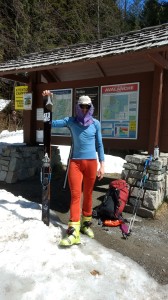
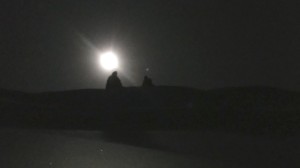
Nice! I spent the night up at Russet Lake Saturday, waffling on whether to ski either to Blackcomb or to Currie. Decided against it because of the potential whiteouts and my lack of ski crampons. Nice to just learn from you I was in for.
How was the fall hazard in general? Can your fabric boots climb snow well at all?
Also, was this trip brought to you by Red Bull?
Awesome Christian, what an adventure.
I think this trip was brought to Christian by SunRype And that by ‘muscl[ing his] way up’, Christian means he took off the flexy tele boots and used his retractable ice claws instead. You only get the ability to grow them on full moons, and only after doing a 6000m+ ski day.
And that by ‘muscl[ing his] way up’, Christian means he took off the flexy tele boots and used his retractable ice claws instead. You only get the ability to grow them on full moons, and only after doing a 6000m+ ski day.
Amazing job Christian!!!
Vincent Chan-Ying and I passed by you on our way down from Elfin, having no idea you were just starting off on this grand adventure. Awesome trip report and awesome job!
Truly inspiring, Christian. Though, once again, conditions were tougher than hoped for (which is starting to seem like a likely outcome outside that coveted one-in-a-decade window) you went ~90km in a little more than a day on skis! That’s a pretty intriguing data point on the quest for high-speed icefield traverses.
Thanks for writing up your report. Excellent motivation for me to ski a lot more…
I actually didn’t take my fabric boots on this trip. I’ve found that, although that setup saves something like 2kg over my plastic boot with tele-tech setup (400g of that is the heavier skis that go along with the setup), it’s not worth it for trips > 4000m. It just takes too much concentration when skiing down, and even when skinning up. The plastic boots hold everything in place, and I can turn my brain off and just slog on the uphill and rip with confidence on the downhill. I was quite glad to have the plastic boots in the McBride; there were a few places one would not want to fall.
The fabric boots do climb snow surprisingly well for what they are, though. The sole is fairly heavy so they kick in somewhere between full and half-shank leather mountaineering boots.
Sometimes conditions are tougher than hoped for, but I’ve had my share of “good luck” too.
Thanks everybody!
I’m curious about your choice of nutrition … sustaining yourself on a 29hr push with sugar alone minus the 1 energy bar that has some protein/fat. I had assumed that over very long activity periods, the body gets into a fat-burning metabolism, and eating fatty foods would help fuel that long-term push. Based on this impressive effort, it seems like it can function all right on sugar. What are your thoughts on your choice of calorie intake (carb/fat/protein) for these sorts of things?
Certainly don’t mistake me for somebody who knows a lot about nutrition… I’m just some guy who managed to ski for 29 hours. But, here goes:
From my reading it seems like people agree that on endurance events your body gets into a fat burning metabolism… 29 hours probably counts as endurance. The week before I tried to eat a ton of fat, the day before I tried to eat mostly carbs, and the day of I ate mostly sugar. It just seemed like the thing to do, based loosely on some reading. I thought about trying to bring more fat, based on the same reading – but when I’d started training more seriously this winter (before doing any reading on nutrition) I found that on my training trips (which went up to about 4000 m / 7 hours), my body was happy eating around 50g/h of mostly fruity bars. They still tasted fine by the end, weren’t particularly expensive, I didn’t feel hungry afterwards, and I might even be able to convince myself they are healthy since they are made from fruit. I also found that I could do about 2000 m / 3.5 hours without eating anything at all, but would feel really hungry the next day. My training trips were on the weekend, and during the week I tend to eat a lot more fat/protein.
In the end I decided not to mess with success, so just brought what my body seemed to be able to handle (except for that protein bar, which my body refused to eat – I actually carried it out half-eaten). I think that, for next season, I’m going to do a bit more experimenting with nutrition. But for the remainder of this spring I’m going to stick with fruity bars since it’s what I trained on.
Those red tights…